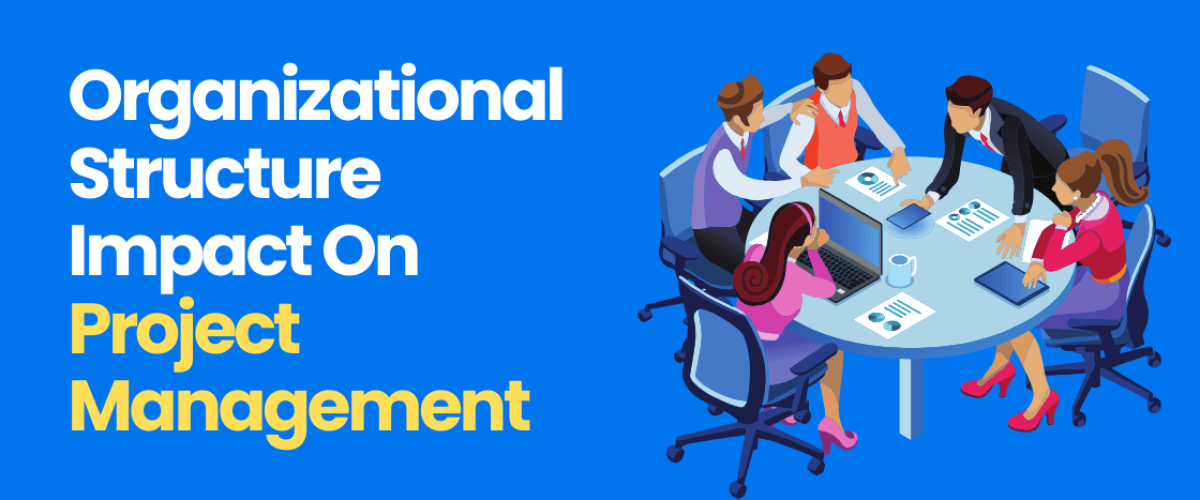A company’s organizational structure influences project management success by affecting communication, decision-making, resource allocation, and team collaboration, impacting efficiency and project outcomes.
The way a company is structured can either support or hinder project success. A clear, well-defined structure helps in assigning responsibilities and streamlining communication. On the other hand, a poorly organized structure can lead to confusion and delays. Understanding this impact is essential for effective project management.
In this blog post, we will explore how different organizational structures influence project management. You’ll learn about the benefits and challenges each type presents. Whether you are a project manager or a business leader, this insight will help you improve project outcomes and efficiency. Stay with us to uncover the key connections between organizational structure and project management success.

Credit: www.youtube.com
Importance Of Organizational Structure
An organization’s structure is crucial. It shapes every aspect of operations. This includes project management. The right structure can enhance efficiency. It can also improve communication. Poor structure, on the other hand, can create confusion. It can lead to delays and increased costs. Understanding the importance of organizational structure is key. It helps in successful project management.
Defining Organizational Structure
Organizational structure defines roles. It also outlines responsibilities. It shows how tasks are divided. It clarifies who reports to whom. This structure can be hierarchical. It can also be flat. Each type of structure has its benefits. The choice depends on the company’s goals. It also depends on its size and industry.
Role In Project Management
The structure impacts project management. It dictates the flow of information. It affects decision-making processes. A clear structure helps in assigning tasks. It ensures accountability. It also helps in setting priorities. With a good structure, projects run smoothly. Deadlines are met. Resources are used efficiently.
In project management, communication is vital. A structured organization improves communication. It reduces misunderstandings. It ensures everyone is on the same page. This leads to better project outcomes.
| Organizational Structure | Impact on Project Management |
|---|---|
| Hierarchical | Clear chain of command, better accountability |
| Flat | Faster decision-making, increased flexibility |
Key Takeaways:
- Organizational structure defines roles and responsibilities.
- It impacts communication and decision-making in project management.
- A clear structure ensures accountability and efficient resource use.

Credit: kolapp.com
Types Of Organizational Structures
A company’s organizational structure affects how projects are managed. It influences communication, decision-making, and resource allocation. There are three main types of organizational structures:
Functional Structure
In a Functional Structure, the company is divided into departments. Each department specializes in a particular function, such as marketing or finance.
| Advantages | Disadvantages |
|---|---|
| Clear hierarchy | Poor communication between departments |
| Specialized skills | Slow decision-making |
Project managers have limited authority. They often need approval from department heads. This can slow down project progress.
Matrix Structure
The Matrix Structure blends functional and projectized structures. Employees report to both functional managers and project managers.
- Improved communication
- Better resource allocation
- Dual reporting can cause confusion
This structure allows for flexibility. It can be challenging due to dual authority. But, it helps in optimal resource use.
Projectized Structure
In a Projectized Structure, the focus is on projects. Project managers have full authority over the project.
- High project focus
- Fast decision-making
- Resource duplication
Teams work closely on projects. This ensures better control and quick decisions. But, it can lead to resource duplication.
Impact On Communication
A company’s organizational structure plays a key role in how information flows. It affects the speed and clarity of communication. This impacts project management in many ways. Let’s explore some aspects of this impact.
Information Flow
In a hierarchical structure, information flows from top to bottom. This can cause delays. Team members wait for approval from higher-ups. In contrast, a flat structure allows direct communication. This speeds up the information flow.
For example, in a matrix structure, team members report to multiple managers. This can lead to confusion and mixed messages. Clear guidelines are needed to manage this complexity.
Consider the use of communication tools. In a centralized structure, a single platform may be used. In a decentralized structure, various tools might be in play. This can either streamline or complicate information flow.
Decision-making Processes
Decision-making processes are closely tied to the organizational structure. In a tall structure, decisions are made at higher levels. This can slow down project progress. Lower levels must wait for approvals.
On the other hand, in a flat structure, decisions are made at all levels. This speeds up the process. Team members have more autonomy. They can make quick adjustments as needed.
Let’s compare different structures in a table:
| Structure | Decision-Making Speed | Autonomy |
|---|---|---|
| Hierarchical | Slow | Low |
| Flat | Fast | High |
| Matrix | Moderate | Medium |
In summary, the company’s structure impacts both information flow and decision-making. This, in turn, affects project management. Choosing the right structure can lead to more effective communication and quicker decision-making.
Resource Allocation
Resource allocation refers to the distribution of resources among various projects. It plays a crucial role in project management. Effective resource allocation ensures that projects are completed on time and within budget. A company’s organizational structure can significantly impact how resources are allocated. Let’s explore this through two key aspects: efficient resource use and resource conflicts.
Efficient Resource Use
Efficient use of resources is vital for project success. A well-structured organization ensures that resources are used optimally. This means that skilled employees are assigned to tasks that match their expertise. It also involves using physical resources, such as equipment and materials, wisely.
For instance, in a matrix structure, resources can be shared across projects. This allows for flexibility and better utilization of skills. A table below highlights the benefits of efficient resource use:
| Benefit | Description |
|---|---|
| Cost Savings | Optimal use of resources reduces waste and saves money. |
| Higher Productivity | Right resources on the right tasks increase efficiency. |
| Project Success | Proper allocation leads to timely project completion. |
Resource Conflicts
Resource conflicts occur when multiple projects need the same resources. This is common in organizations with multiple ongoing projects. A clear structure helps in resolving these conflicts efficiently.
In a functional structure, resources are divided by department. This can lead to resource hoarding. In contrast, a matrix structure allows resources to be shared. This reduces conflicts as resources are allocated based on project needs.
Below are some common resource conflicts and solutions:
- Double Booking: Ensure clear communication and scheduling tools to avoid overlap.
- Resource Shortage: Prioritize projects and allocate resources to critical tasks first.
- Skill Mismatch: Provide training or hire temporary skilled workers to fill gaps.
By addressing these conflicts, organizations can maintain smooth project progress. This ultimately leads to successful project completion.
Team Dynamics
The organizational structure of a company plays a crucial role in shaping team dynamics. It defines how teams collaborate, communicate, and resolve conflicts. A well-defined structure can foster a productive environment, enhancing project management efficiency. Let’s delve into the two key aspects of team dynamics: collaboration and conflict resolution.
Collaboration
Effective collaboration is essential for successful project management. The organizational structure impacts how team members interact and share information. In a hierarchical structure, communication flows through defined channels, often leading to slower decision-making. On the other hand, a flat structure encourages open communication, promoting quicker responses and innovative solutions.
Here are some ways organizational structure influences collaboration:
- Clear Roles: Defined roles ensure everyone knows their responsibilities.
- Communication Channels: Established channels streamline information flow.
- Resource Allocation: Proper allocation prevents resource conflicts.
Conflict Resolution
Conflict is inevitable in any team setting. The way a company is structured affects how conflicts are addressed and resolved. In a centralized structure, conflicts may be escalated to higher management, potentially causing delays. Conversely, a decentralized structure empowers teams to handle conflicts internally, promoting a quicker resolution.
Key elements of conflict resolution influenced by organizational structure include:
- Decision Authority: Who has the final say in resolving conflicts?
- Conflict Escalation: Are there clear steps for escalating issues?
- Support Systems: Are there resources for mediating conflicts?
Understanding these aspects can help companies design structures that enhance both collaboration and conflict resolution, leading to more effective project management.

Credit: www.growth-hackers.net
Role Clarity
Role Clarity in a company’s organizational structure is vital for effective project management. Clear roles help reduce confusion and increase efficiency. Team members know their responsibilities, which leads to better performance. Let’s explore how defining roles and distributing responsibility can impact project management.
Defining Roles
Defining roles ensures each team member understands their specific tasks. This step helps in setting clear expectations. For instance, a project manager oversees the entire project. A developer focuses on coding. A tester ensures the quality of the product.
Clear roles prevent overlapping duties. This helps avoid conflicts and duplications. Everyone knows their part and works towards a common goal. This clarity boosts productivity and morale.
Responsibility Distribution
Responsibility distribution involves assigning tasks based on skills and strengths. This process ensures that every team member works on what they do best. It also spreads the workload evenly.
Responsibility distribution can be illustrated in a table format for better understanding:
| Role | Responsibility |
|---|---|
| Project Manager | Oversees the project, manages timelines and budget |
| Developer | Codes and develops the project |
| Tester | Tests the project for bugs and issues |
Distributing responsibilities correctly ensures every aspect of the project is covered. It also empowers team members. They feel accountable for their tasks. This sense of ownership enhances their commitment to the project.
Project Flexibility
Project Flexibility is crucial for successful project management. A company’s organizational structure can greatly influence this flexibility. It determines how quickly a team can adapt to changes and scale projects effectively.
Adapting To Changes
In a flexible organizational structure, teams can quickly adjust to new demands. They can easily switch priorities based on project needs. This adaptability is key in today’s dynamic business environment.
For example, in a matrix structure, employees report to multiple managers. This allows them to shift focus swiftly without much bureaucratic delay. It ensures that projects remain on track despite unforeseen changes.
Alternatively, a hierarchical structure might slow down this process. Teams may need multiple approvals before making changes. This can hinder project progress and affect timelines.
Scalability
Scalability refers to a project’s ability to grow and manage increased demand. An effective organizational structure supports this growth seamlessly.
In a flat organizational structure, there are fewer management levels. This can lead to faster decision-making and easier expansion. Teams can add new members without significant restructuring.
Conversely, in a tall organizational structure, adding new members requires more planning. The complex hierarchy can slow down the process. This can impact the project’s ability to scale efficiently.
Below is a comparison of how different structures impact scalability:
| Organizational Structure | Impact on Scalability |
|---|---|
| Flat | Faster decision-making, easier expansion |
| Tall | Slower process, requires more planning |
| Matrix | Flexible but can be complex |
Measuring Project Success
Measuring project success is crucial for any company. It helps to understand the effectiveness of their project management. A well-structured organizational framework can greatly influence this measurement. It ensures that the right metrics and feedback mechanisms are in place.
Key Performance Indicators
Key Performance Indicators (KPIs) are vital for measuring project success. They provide clear and measurable values that reflect project performance. Common KPIs include:
- Project Completion Time: Tracks if the project is on schedule.
- Budget Adherence: Monitors if the project stays within financial limits.
- Quality Standards: Ensures the project meets quality benchmarks.
- Stakeholder Satisfaction: Gauges the contentment of those involved.
These indicators help project managers make informed decisions. They also highlight areas needing improvement. Consistent tracking of KPIs can lead to better project outcomes.
Feedback Mechanisms
Effective feedback mechanisms are essential for measuring project success. They provide insights into the project’s progress and areas for improvement. Feedback can be gathered through:
- Regular Team Meetings: Facilitates open communication and issue resolution.
- Surveys and Questionnaires: Collects feedback from stakeholders and team members.
- Performance Reviews: Evaluates individual contributions and project success.
- Client Feedback: Gathers insights from the end users or clients.
Implementing these mechanisms ensures continuous improvement. It also fosters a culture of transparency and accountability. This approach helps in aligning project outcomes with organizational goals.
Frequently Asked Questions
How Does Organizational Structure Affect Project Management?
The organizational structure influences project management by determining authority, communication flow, and resource allocation. It impacts efficiency and decision-making.
What Are The Types Of Organizational Structures?
Common types include functional, matrix, and projectized structures. Each has unique advantages and challenges for project management.
How Does A Functional Structure Impact Projects?
In a functional structure, projects may face slower decision-making. Resources are often shared, causing potential delays and conflicts.
Why Is Matrix Structure Beneficial For Projects?
Matrix structure allows resource sharing across projects. It enhances flexibility and communication but may lead to confusion in authority.
Conclusion
A company’s organizational structure greatly influences project management success. Clear roles help teams work efficiently. Effective communication reduces misunderstandings. A well-defined structure ensures accountability. It fosters collaboration across departments. Adapting the structure to project needs boosts performance. Proper alignment with business goals drives growth.
Choose the right structure to enhance project outcomes. Make smart decisions for better project management.

